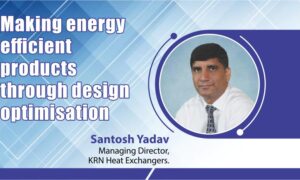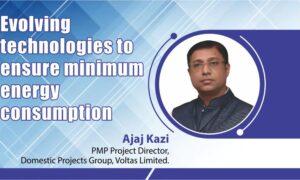With an intense rebranding strategy in place to capitalise both brand loyalty of Anchor and Panasonic, Dinesh Aggarwal, Joint Managing Director, in an interaction with Thermal Control Business Update, shares his views on how Panasonic is expanding in high potential clean air market in India.
What are the major challenges in India to sell clean air indoor products?
I think that consciousness about the quality of air is not so strong right now, especially in homes, office spaces and public places such as theatres. When an office is designed, the concern essentially is about the temperature, humidity and not so much about the amount of air changes required to maintain the right level of particulate matters and VOCs. These pollutants have a direct bearing on the wellbeing and thus productivity of the employees in an office setting. This consciousness is gradually beginning to grow; especially amongst the multinational companies. Most MNCs have well laid specifications, which include air quality monitoring requirement; and thus have their offices in India designed accordingly.
I am expecting an increase in awareness with more developers, companies and HVAC consultants coming in from abroad and participating in projects here.
A lot of investment in the commercial space is happening not only by the Indian companies, but also by foreign companies, like an American multinational private equity firm, which is acquiring leased assets and has become the largest owner of office space in India. The increasing investment by MNCs and expansion by large Indian companies are creating demand for high grade offices and commercial infrastructure such as hotels, shopping malls etc. This is raising the awareness and demand for air quality considerably.
We have been selling the basic products such as ceiling fans and wall mounted ventilation fans for many years across the world and Panasonic is amongst the top three largest players in Fans globally.
What is not so well known in India is Panasonic’s expertise in commercial ventilation with energy recovery and built-in air purification. We have started our work in educating various stakeholders about Panasonic ERV (Energy Recovery Ventilation) and are simultaneously offering an integrated system that can sense air temperature, humidity and air quality, controlling the HVAC system accordingly.
Considering the pollution levels, especially in cities like Delhi; do you think government also should take some measures or mandates on it?
Yes! Over the years government has taken significant steps to reduce the air pollution including the implementation of BS-VI norms for vehicles by 2020. The present government has a strong commitment to electric vehicles, personal and commercial. It’s taking steps to ensure that at least 30 per cent of vehicles on road shall be electric by the year 2030.
To ensure faster adoption, government will need to incentivise the purchase of EV and my belief is that government will initially support the public transport viz.; especially the intra-city buses. Subsequently (or in parallel), electric passenger cars will be incentivised through subsidy on road tax or overall taxes; to ensure a lower cost.
Over the years, each of the state governments has become tighter on control of industrial pollution and disposal of hazardous waste. We have seen it at all our factory locations and we have ensured that our factories are 100 per cent compliant.
How far do you think is India matured to adopt your energy management solutions?
There is an increase in awareness about monitoring and reducing energy consumption. This is being driven by the utilities and by the rising consciousness in the society. The industry has been incentivised by the utilities through subsidised tariffs for high power factory and through use of renewable energy.
We believe that there is an increasing consciousness amongst individuals and in the commercial spaces to monitor and control energy consumption and we have, thus, launched some very cost effective systems that can help in optimising the use of artificial lighting and air conditioning based on occupants, ambient temperature, external natural light condition and time of the day.
A large part of energy does not get measured and paid for. This is due to many reasons including faulty meters, tampering of meters, inefficient recording of the usage etc. We are thus introducing “smart meters”, which can be controlled remotely and recorded. This meter will also save the manpower costs for a utility company and will ensure accuracy of billing. We expect all the utilities to adopt smart meters or convert the existing electronic meters to smart meters; which will also help them study and do the demand planning more effectively.
Walk us through how rebranding from Anchor to Panasonic happened?
We have only changed the name of the company, in line with change in our parent company’s name. For products, we continue to use & promote both, Panasonic and Anchor, as our brands, which we have been doing from the date of acquisition.
Panasonic Life solutions Ltd. (earlier known as Panasonic ES Company) is a division of Panasonic Corporation.
It was a good opportunity to change our company’s name to be in line with our parent company and this has been pending since acquisition. In the initial years after acquisition, we did not change the name of the company from Anchor to Panasonic because there were a lot of things that needed to be set right; in terms of product quality, internal controls and processes, various compliances, etc. Since then, we have come a long way, and we today are a robust company with strong processes and controls in line with our parent company and we believe that we rightfully have become a Panasonic Company; with its strong values.
Apart from the upcoming manufacturing facility in Andhra Pradesh, which are the other facilities Panasonic have in India? What percentage of capacity is utilised at this point?
Presently, we have three facilities in Daman, one factory in Gujarat and two factories in Haridwar. The capacity utilisation is around 70 to 80 per cent and thus our rationale for establishing another manufacturing unit in about two years time; in South India, which is our largest region in sales.
What kind of investment do you have presently in India for Panasonic?
Post-acquisition, every year we have invested around ₹200 crore annually on capacity enhancement, quality improvement and product development. We invested a lot in new tools and moulds. We invested in injection moulding and compression moulding machines and their automation.
We invested in a greenfield factory in Daman (2011) , followed by another one in Haridwar (2016). Over the past 12 years, we have invested between ₹2,500 to 3,000 crores; without the inclusion of our investment in brand strengthening and build up. Over ₹500 crores have been invested in enhancement of our brand image over these years.
Panasonic has multiple entities in India and some of these have been in India for a long time and have made substantial investment individually viz. Panasonic Appliances, Panasonic Batteries, Panasonic Carbon etc. Panasonic has also made a very large investment in Jhajjar for manufacture of consumer appliances and welding robots for the automobile manufacturing.
India is an important country for Panasonic and our commitment keeps increasing year on year; not only as a consumption market but also as a design , development and a manufacturing base for the region.
The increasing investment by MNCs and expansion by large Indian companies are creating demand for high grade offices and commercial infrastructure
Dinesh Aggarwal, Joint Managing Director, Panasonic Life Solutions India Private Limited
Cookie Consent
We use cookies to personalize your experience. By continuing to visit this website you agree to our Terms & Conditions, Privacy Policy and Cookie Policy.















